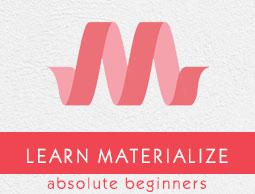Materialize - Environment Setup
In this chapter, we will discuss on the different aspects of setting up a congenial environment for Materialize.
Try it Option Online
We have set up the Materialize Programming environment online, so that you can compile and execute all the available examples online. It gives you confidence in what you are reading and enables you to verify the programs with different options. Feel free to modify any example and execute it online.
Try the following example using our online compiler available at CodingGround
<!DOCTYPE html>
<html>
<head>
<title>The Materialize Example</title>
<meta name = "viewport" content = "width = device-width, initial-scale = 1">
<link rel = "stylesheet"
href = "https://fonts.googleapis.com/icon?family=Material+Icons">
<link rel = "stylesheet"
href = "https://cdnjs.cloudflare.com/ajax/libs/materialize/0.97.3/css/materialize.min.css">
<script type = "text/javascript"
src = "https://code.jquery.com/jquery-2.1.1.min.js"></script>
<script src = "https://cdnjs.cloudflare.com/ajax/libs/materialize/0.97.3/js/materialize.min.js">
</script>
</head>
<body>
<div class = "card-panel teal lighten-2"><h3>Hello World!</h3></div>
</body>
</html>
For most of the examples given in this tutorial, you will find a Try it option in our website code sections at the top right corner that will take you to the online compiler. So just make use of it and enjoy your learning.
How to Use Materialize?
There are two ways to use Materialize −
Local Installation − You can download the materialize.min.css and materialize.min.js files on your local machine and include it in your HTML code.
CDN Based Version − You can include the materialize.min.css and materialize.min.js files into your HTML code directly from the Content Delivery Network (CDN).
Local Installation
Example
Include the css and js file in your HTML file as follows.
<!DOCTYPE html>
<html>
<head>
<title>The Materialize Example</title>
<meta name = "viewport" content = "width = device-width, initial-scale = 1">
<link rel = "stylesheet"
href = "https://fonts.googleapis.com/icon?family=Material+Icons">
<link rel = "stylesheet" href = "/materialize/materialize.min.css">
<script type = "text/javascript"
src = "https://code.jquery.com/jquery-2.1.1.min.js"></script>
<script src = "/materialize/materialize.min.js"></script>
</head>
<body>
<div class = "card-panel teal lighten-2"><h3>Hello World!</h3></div>
</body>
</html>
It will produce the following result.
CDN Based Version
You can include the materialize.min.js and materialize.min.css files into your HTML code directly from the Content Delivery Network (CDN). cdnjs.cloudflare.com provides content for the latest version.
We are using cdnjs.cloudflare.com CDN version of the library throughout this tutorial.
Example
Rewrite the above example using materialize.min.css and materialize.min.js from cdnjs.cloudflare.com CDN.
<!DOCTYPE html>
<html>
<head>
<title>The Materialize Example</title>
<meta name = "viewport" content = "width = device-width, initial-scale = 1">
<link rel = "stylesheet"
href = "https://fonts.googleapis.com/icon?family=Material+Icons">
<link rel = "stylesheet"
href = "https://cdnjs.cloudflare.com/ajax/libs/materialize/0.97.3/css/materialize.min.css">
<script type = "text/javascript" src = "https://code.jquery.com/jquery-2.1.1.min.js">
</script>
<script src = "https://cdnjs.cloudflare.com/ajax/libs/materialize/0.97.3/js/materialize.min.js">
</script>
</head>
<body>
<div class = "card-panel teal lighten-2"><h3>Hello World!</h3></div>
</body>
</html>
It will produce the following result −


